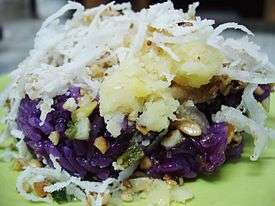Peristrophe roxburghiana
| Peristrophe roxburghiana | |
|---|---|
 | |
| Scientific classification | |
| Kingdom: | Plantae |
| (unranked): | Angiosperms |
| (unranked): | Eudicots |
| (unranked): | Asterids |
| Order: | Lamiales |
| Family: | Acanthaceae |
| Genus: | Peristrophe |
| Species: | P. roxburghiana |
| Binomial name | |
| Peristrophe roxburghiana (Roem. & Schult.) Bremek. | |
Peristrophe roxburghiana (syn. Peristrophe tinctoria Nees, Peristrophe baphica (Spreng) Bremek.; also called magenta plant, or lá cẩm in Vietnamese) is a flowering plant in the family Acanthaceae, native to southeastern Asia from Assam south to Sri Lanka and east to mainland Southeast Asia, Java, southern China, and Taiwan.[1][2][3]
Description
It is a herbaceous perennial plant growing to 50–100 cm tall. The leaves are lanceolate to ovoid-acute, 2–7.5 cm long and 1–3.5 cm wide. The flowers are two-lobed, the long axis up to 5 cm long; they are magenta to reddish-violet.[1][2][4][5]
Cultivation and uses
Culinary use

An extract of its leaves is used as a food dye, and imparts a magenta tone to some Vietnamese foods, particularly in a taro-filled cake called bánh da lợn and glutinous rice dishes such as xôi lá cẩm, a sweet dessert.
Medicinal use
The plant is used in traditional Chinese medicine. The leaves have been used in water extract decoctions for the treatment of ailments including cough, dysentery, diarrhoea and bronchitis.[6]
References
- 1 2 Flora of Taiwan: Peristrophe roxburghiana.
- 1 2 Flora of China (draft): Acanthaceae.
- ↑ Germplasm Resources Information Network: Peristrophe roxburghiana.
- ↑ Taiwan Forestry Flora of Taiwan 4: 183: in Chinese; google translation.
- ↑ photo
- ↑ Tanaka, Yoshitaka; Van Ke, Nguyen (2007). Edible Wild Plants of Vietnam: The Bountiful Garden. Thailand: Orchid Press. p. 16. ISBN 9745240893.